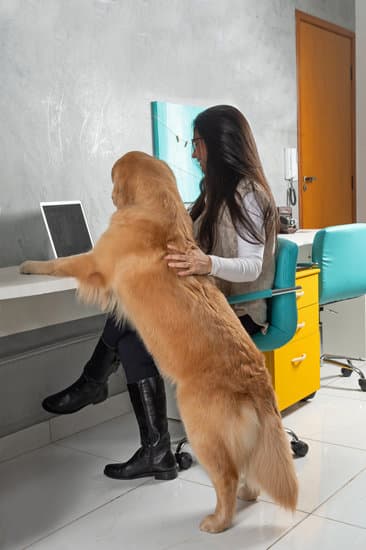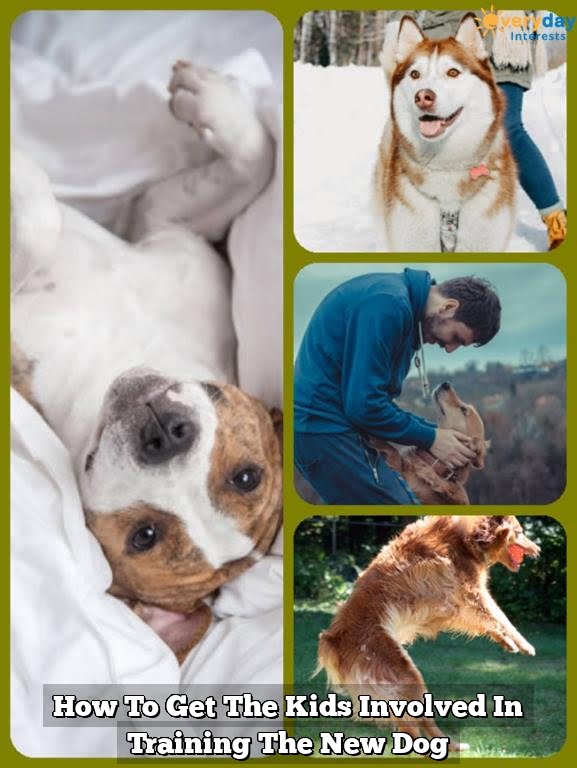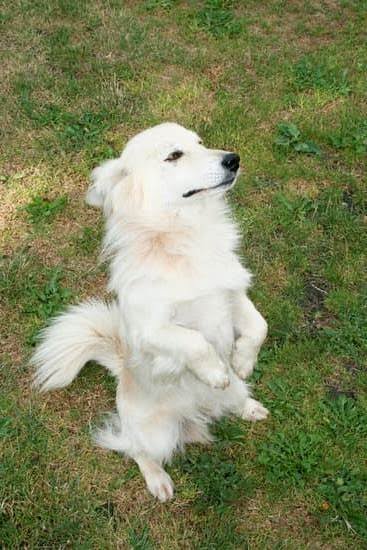Getting kids involved in training the family dog is not only a fun and educational experience, but also a valuable opportunity for personal growth and development. In this introductory section, we will explore why it is important to involve children in training the dog, and how this involvement can benefit both the child and the furry companion.
Training the family dog with the help of children creates a sense of responsibility and encourages teamwork within the household. Not only does it teach kids about empathy and understanding towards animals, but it also instills in them a strong work ethic that can be applied to various areas of their lives. By actively participating in training sessions, children learn valuable life lessons such as patience, consistency, and communication skills.
Additionally, involving kids in training helps to establish a strong bond between them and their furry friend. By working together towards a common goal, children develop trust and respect for their pet while also gaining confidence in their own abilities. This mutual understanding fosters a sense of companionship and strengthens the overall relationship between the child and the dog.
In the following sections of this article, we will delve into specific steps to ensure successful involvement of kids in dog training. From laying down the foundation of understanding about dog behavior to creating engaging activities for both kids and dogs, we will provide practical strategies for parents to implement. So grab your pen and paper because it’s time to embark on an exciting journey of involving your children in training your family dog.
Setting the foundation
Teaching kids about basic dog behavior and psychology is an essential step in getting them involved in training the family dog. By understanding how dogs think and behave, children can develop a deeper connection with their furry friend and become more effective trainers.
To set the foundation, parents can start by explaining to their kids that dogs have their own unique ways of communicating and interacting with the world. They can emphasize that understanding these cues is crucial in building trust and establishing a positive relationship with the dog. Some key concepts to cover include:
- Body language: Teach children how to interpret a dog’s body language signals such as tail wagging, ear positioning, and posture. Explain that these cues can indicate if a dog is feeling happy, relaxed, scared, or agitated.
- Socialization: Help children understand the importance of socializing dogs at an early age to ensure they are comfortable around people, other animals, and different environments.
- Reinforcement: Introduce the concept of positive reinforcement to children and explain how rewarding desired behaviors with treats or praise can encourage dogs to repeat those behaviors in the future.
Parents can make this learning process fun for kids by using visual aids such as books or videos that illustrate various dog behaviors. They can also engage children in interactive activities like role-playing scenarios where they act as both the dog and trainer while mimicking different body language cues.
By setting this foundation of knowledge about basic dog behavior and psychology, children will be better equipped to navigate training sessions effectively and develop a strong bond with their furry companion.
Building responsibility
When it comes to involving kids in training the family dog, building responsibility is a crucial aspect. Assigning age-appropriate tasks not only helps develop important life skills in children but also allows them to take an active role in shaping their furry companion’s behavior. By assigning tasks that are suitable for their age and capabilities, kids can feel a sense of accomplishment and ownership over their contributions to the dog’s training.
Identifying age-appropriate tasks
Assigning age-appropriate tasks requires careful consideration of a child’s abilities and understanding of dog behavior. For young children, simple tasks like filling up the dog’s water bowl or assisting with feeding can help them learn about responsibility and daily care. As they grow older, they can take on more challenging responsibilities, such as teaching basic commands like sit or stay, grooming the dog under supervision, or helping with positive reinforcement during training sessions.
Teaching through guidance and supervision
It is essential for parents to provide proper guidance and supervision while kids handle tasks during dog training. This ensures both the safety of the child and the well-being of the dog. Parents should demonstrate how each task should be performed correctly and offer constructive feedback along the way. By doing so, children will develop a deeper understanding of their role in training the dog and learn valuable lessons in patience, empathy, and communication.
Promoting teamwork
Assigning responsibilities in dog training also creates opportunities for teamwork between family members. Encourage siblings to work together by assigning them joint tasks that require cooperation and coordination. This not only fosters a sense of unity among siblings but also strengthens their bond with the family pet as they navigate training challenges together.
By building responsibility through assigned tasks, children are empowered to actively contribute to their pet’s development while developing important life skills. It is crucial for parents to encourage and provide guidance along the way, ensuring a positive and rewarding experience for both the kids and the dog.
Fun and engaging activities
Incorporating play into training sessions
One of the best ways to make dog training fun for kids is by incorporating play into the sessions. For example, instead of simply asking your child to practice basic commands like “sit” and “stay,” turn it into a game of Simon Says. Have your child give the command and then pretend to be the dog following the instruction. This not only keeps things entertaining but also helps reinforce learning in a playful manner.
Teaching tricks and agility exercises
Another fun and engaging activity for kids during dog training is teaching tricks and agility exercises. Kids can learn how to train dogs to do things like shake hands, roll over, or jump through hoops. These activities provide a sense of accomplishment for both the child and the dog, as they work together to achieve a new skill or trick.
In addition, agility exercises such as weaving through cones or jumping over hurdles can be set up in the backyard for children and dogs to practice together. Not only does this provide physical exercise for both, but it also strengthens their bond as they navigate through the course together.
Creating scavenger hunts
Scavenger hunts are another creative way to make training sessions enjoyable for kids and dogs alike. Hide treats around the house or outdoor area, and have your child guide the dog to find them using commands such as “find it” or “search.” This activity stimulates both mental and physical exercise for the dog while allowing children to actively participate in their training.
By incorporating these fun and engaging activities into training sessions with their furry companion, kids will not only develop valuable skills in working with dogs but also cultivate a love for training that will benefit them throughout their lives.
Positive reinforcement
Understanding the Concept of Positive Reinforcement
Positive reinforcement is a powerful tool in dog training that involves rewarding and praising desired behaviors. It is important for kids to understand this concept as it helps them shape good behavior in dogs effectively. By teaching kids about positive reinforcement, they can learn to identify the behaviors they want to encourage and reinforce them in a way that makes training enjoyable for both the dog and themselves.
Choosing Effective Rewards
When teaching kids the power of rewards, it is crucial to emphasize the importance of using rewards that are meaningful to the dog. Kids can be encouraged to experiment with different types of rewards such as treats, praise, or playtime to see what motivates their furry friend the most.
For instance, some dogs may be more food-driven, while others may respond better to verbal praise or a favorite toy. This process enables kids to understand that positive reinforcement is not a one-size-fits-all approach and that each dog may have unique preferences.
The Role of Praise and Encouragement
Apart from physical rewards, teaching kids the significance of praise and encouragement is essential in shaping good behavior in dogs. Kids should learn how to offer verbal cues or commands followed by immediate praise when their dog performs a desired behavior correctly. Praising the dog helps reinforce the connection between their actions and positive outcomes, motivating them to continue exhibiting those behaviors.
Encouraging children to use positive reinforcement effectively helps them develop patience, empathy, and an understanding of how their behavior can influence others, including animals. This approach creates a positive atmosphere during training sessions and builds trust between kids and their furry companions as they work together towards achieving common goals.
Consistency is key
One of the key factors in successful dog training is consistency. This applies not only to the training techniques used, but also to the schedule and expectations for regular training sessions. Establishing a consistent routine is crucial for both the dog and the child involved in training. It helps create structure and promotes better learning for both parties.
To establish a schedule for regular training sessions, parents can work with their children to decide on specific days and times that are convenient for everyone. This could be daily, every other day, or even a few times a week depending on what works best for the family’s schedule. By consistently setting aside dedicated time for training, children will understand the importance of commitment and responsibility.
In addition to scheduling regular training sessions, it’s important to establish clear expectations for these sessions. Children should have a good understanding of what behaviors they are working on with their dog during each session. Creating a checklist or a list of specific tasks to accomplish can be helpful in keeping everyone focused and on track. Encourage children to set goals for each session and celebrate when those goals are achieved.
Overall, consistency in scheduling and expectations sets the foundation for successful dog training. It teaches children valuable life skills such as commitment and responsibility while also helping dogs learn more effectively. With a consistent routine in place, both children and dogs will benefit from improved behavior and strengthened bonds.
Bonding opportunities
Training the family dog provides an excellent opportunity for children to develop a deeper bond with their furry companions. By involving kids in the training process, not only are they learning how to teach their dogs essential skills, but they are also fostering a stronger connection based on trust, respect, and cooperation. This section will discuss the various ways in which training the dog together can enhance the bond between kids and their four-legged friends.
One of the significant benefits of training sessions is that they encourage teamwork between children and their dogs. Working together towards a common goal strengthens the bond between them as they learn to communicate effectively and understand each other’s needs. When kids see their efforts paying off in terms of their dog’s progress, it boosts their confidence and creates a sense of achievement.
In addition to enhancing communication, training sessions provide ample opportunities for positive reinforcement and bonding through play. Incorporating interactive games into training exercises not only makes it more enjoyable for both kids and dogs but also deepens their relationship. For example, teaching tricks like playing fetch or hide-and-seek encourages dogs to trust and rely on children while providing a fun experience that strengthens the emotional connection between them.
| Activity | Description |
|---|---|
| Treat Search | Hide treats around the house or yard for your child to guide their dog to find using commands like “go find” or “search.” |
| Obstacle Course | Create an obstacle course using everyday household objects such as cushions or broomsticks for your child to guide their dog through using cues and hand signals. |
| Show and Tell | Have your child teach their dog a new trick or command, and then let them demonstrate it to the family. This activity boosts your child’s confidence and strengthens their bond with their dog. |
Safety first
When involving kids in the training of the family dog, it is crucial to prioritize safety. Teaching children about safety guidelines not only ensures their well-being but also helps them develop respect and empathy towards animals. Here are some important safety guidelines to educate kids on when working with dogs:
- Respect personal space: Teach children to always respect the dog’s personal space and boundaries. It’s important for kids to understand that even though they may love playing with their furry friend, dogs need their own space at times.
- Gentle handling: Emphasize the importance of gentle handling when interacting with the dog. Teach kids to avoid pulling on the leash, yanking on collars, or rough play that might cause distress or harm to the dog.
- Supervision: Stress the significance of adult supervision during training sessions. This ensures that both the child and the dog are safe at all times and that any potentially dangerous situations can be identified and prevented.
Furthermore, it is crucial for parents to model safe behavior around dogs and reinforce these guidelines consistently. By instilling responsible behaviors from an early age, children will develop a strong foundation for effective communication and engagement with their canine companions.
| Safety Guidelines |
|---|
| Respect personal space |
| Gentle handling |
| Supervision |
Troubleshooting common challenges
One common challenge that kids may face when training the family dog is getting the dog to listen and obey their commands. It can be frustrating for children when they give a command, such as “sit” or “stay,” and the dog doesn’t respond. One strategy to overcome this obstacle is to teach kids how to use clear and consistent body language when giving commands.
Dogs are highly attuned to visual cues, so showing them what you want them to do can be more effective than simply using verbal commands. Encourage kids to use hand signals along with their verbal commands, and make sure they understand that they need to be patient and persistent in their training efforts.
Another common challenge is when the dog becomes distracted during training sessions. Dogs have a natural curiosity and may easily get sidetracked by smells, sounds, or other animals. To address this issue, it’s important for kids to create a calm and focused environment during training sessions.
Find a quiet space away from distractions where both the child and the dog can concentrate on the task at hand. Establishing a routine for training sessions can also help the dog develop better focus over time.
Finally, some children may feel overwhelmed or afraid when dealing with larger or more energetic dogs. This fear or discomfort can hinder their ability to effectively train the dog. Parents should take these feelings seriously and work gradually with their child to build confidence around dogs.
Start by introducing the child to smaller breeds or calmer dogs, allowing them to observe interactions between responsible adults and well-behaved dogs. Gradually expose them to larger or more energetic dogs under controlled circumstances, taking small steps towards building comfort.
In order to help overcome these common challenges, it’s important for parents to provide guidance and support during training sessions with their child and the family dog. By addressing these obstacles head-on and providing strategies for overcoming them, kids can become more confident trainers while simultaneously strengthening their bond with their furry friend.
| Challenge | Strategy |
|---|---|
| Dog not responding to commands | Teach clear and consistent body language, use hand signals along with verbal commands, be patient and persistent |
| Dog becoming distracted during training sessions | Create a calm and focused environment, find a quiet space away from distractions, establish a routine for training sessions |
| Child feeling overwhelmed or afraid of the dog | Start with smaller or calmer dogs, introduce gradual exposure to larger or more energetic dogs under controlled circumstances, build confidence step-by-step |
Celebrating progress
Achieving progress in training the family dog is an exciting milestone, and it’s essential to celebrate these achievements with kids. By encouraging kids to track and celebrate their training accomplishments, parents can reinforce their efforts and build a sense of pride and motivation in both the child and the dog. Here are some strategies for celebrating progress in dog training:
- Training Journal: Provide each child with a special training journal where they can record their daily or weekly progress. This could include tasks they have successfully accomplished, new commands learned, or any improvements they notice in their dog’s behavior. Encourage children to write down their thoughts, observations, and feelings about the training process as well.
- Reward System: Implement a reward system that allows kids to earn points or badges for each milestone reached during the dog’s training journey. This could be done using a sticker chart or a digital tracking system. Set specific goals for the child and provide them with rewards such as small treats, extra playtime with the dog, or even special outings once they reach certain milestones.
- Showcasing Achievements: Create opportunities for children to showcase their achievements to family members and friends. This could involve inviting loved ones over for a mini-demonstration of the dog’s newly learned skills or capturing short videos of the child and dog in action during training sessions that can be shared on social media platforms.
By celebrating progress in training, children will feel motivated to continue their efforts and establish a lifelong love of working with dogs. It also allows parents to acknowledge their child’s hard work and dedication while strengthening the bond between them and the family pet.
Conclusion
In conclusion, involving kids in training the family dog can have lifelong benefits for both the children and their furry companion. By actively participating in training sessions, kids learn important lessons about responsibility, empathy, and patience. They also develop a deeper understanding of dog behavior and psychology, which can enhance their overall relationship with dogs and other animals.
Through age-appropriate tasks assigned during training, kids gain a sense of accomplishment and confidence as they contribute to shaping their dog’s behavior. Engaging in fun and creative activities during training sessions not only makes it enjoyable for kids but also strengthens the bond between them and their pet. Not only that, but teaching children the power of positive reinforcement helps instill kindness and compassion towards animals.
Establishing a consistent schedule for training sessions not only ensures effective progress but also teaches children the value of discipline and commitment. It provides an opportunity for shared bonding experiences between kids and their furry companion, creating memories that will last a lifetime.
By educating kids on important safety guidelines when working with dogs, parents can instill responsible pet ownership from an early age. Troubleshooting common challenges also helps children develop problem-solving skills while overcoming obstacles encountered in dog training.
Lastly, celebrating progress together as a family reinforces the importance of perseverance and teamwork. Kids can track their achievements in dog training, boosting self-esteem and motivation to continue this journey with their beloved pet.
Involving kids in training the family dog is more than just teaching them how to train an animal; it is about fostering a lifelong love and respect for animals while building valuable life skills. So why wait? Start this journey today with your own children and watch as they grow alongside their dedicated four-legged friend.
Frequently Asked Questions
How do you involve kids in dog training?
To involve kids in dog training, it is important to make the process fun and interactive. One way to do this is by assigning them specific tasks or responsibilities during the training sessions. For example, they can be in charge of teaching the dog basic commands such as sit or stay, under adult supervision.
This not only helps develop their leadership skills but also strengthens the bond between the child and the dog. It is crucial to explain to kids that consistency, patience, and kindness are key when training a dog, emphasizing the importance of positive reinforcement rather than punishment.
How do you positive reinforcement dog training for kids?
Positive reinforcement is an effective method for dog training with kids as it helps create a positive association between desired behaviors and rewards. Children can be taught to use treats, praise, or playtime as rewards when their furry friend obeys commands or exhibits good behavior.
It’s important to teach children how to use positive reinforcement properly, emphasizing that it should be immediate and consistent. This method helps kids understand that they are actively contributing to their pet’s learning process while also promoting a mutual respect and trust between child and dog.
What is the best age to start dog training classes?
The best age to start dog training classes can vary depending on several factors such as the breed, size, and individual temperament of the dog. However, most professional trainers suggest starting at around 3-6 months old for basic obedience classes. Puppies at this age are more receptive to learning new behaviors and adjusting to socializing with other dogs and people outside of their immediate family circle.
It is important not to overwhelm young puppies with too much stimulation or intense training sessions but instead focus on short sessions that prioritize positive experiences while gradually introducing basic commands like sit, stay, and come when called. Early socialization and obedience classes can set a solid foundation for future training endeavors and ensure a well-behaved family pet in the long run.

Welcome to the blog! I am a professional dog trainer and have been working with dogs for many years. In this blog, I will be discussing various topics related to dog training, including tips, tricks, and advice. I hope you find this information helpful and informative. Thanks for reading!





